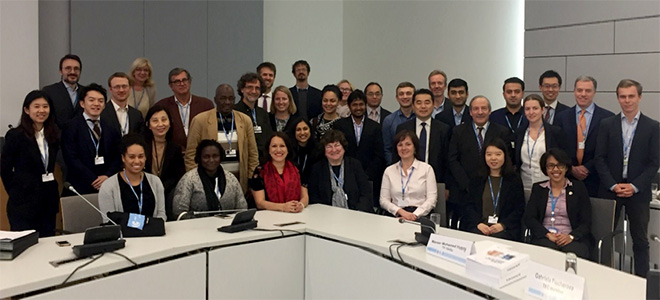
by Marilyn Averill
Senior Fellow at Getches-Wilkinson Center for Natural Resources, Energy, and the Environment
Technology plays a huge role in action on climate change. Implementation of the Paris Agreement will require even more technology-related planning, capacity building, financing, development, and other activities. The United Nations Framework Convention on Climate Change (UNFCCC) does a huge amount of work on climate technologies (as do many other organizations), but few people are aware of this work or the resources available.
In 2001 the parties to the UNFCCC created an Expert Group on Technology Transfer (EGTT). In 2010 the parties ended the EGTT and constructed a Technology Mechanism (TM) to work on issues relating to the development of climate-related technologies, and the transfer of technologies to developing countries. The Technology Executive Committee (TEC) was set up as the policy arm of the TM. The Climate Technology Centre and Network (CTCN) was created as the implementation arm.
The TEC consists of 20 members who are experts on climate-related technologies. Many also serve as negotiators for their countries. The TEC meets at least twice a year. Observers from countries, international organizations, and civil society are invited to attend, and the meetings are webcast. The photo above shows members, observers, and secretariat staff attending TEC 17 last September.
TEC task forces work with the secretariat to implement the TEC’s rolling workplan. Each task force includes a few people from civil society—something few UNFCCC bodies have allowed.
The website for the TM, TT:CLEAR, provides reports, guidance documents, case studies, and other resources useful to anyone interested in the role that technology plays in climate action, and what the parties to the UNFCCC are trying to do to promote and support technology development and transfer. According to TT:CLEAR, “A climate technology is any equipment, technique, practical knowledge or skill needed to reduce greenhouse gas emissions or adapt to climate change.”
The CTCN, based in Copenhagen, provides training and technical support to developing countries through workshops, materials, and direct consulting. Developing countries can request assistance with specific issues, such as conducting a technology needs assessment (TNA). Check out the CTCN website for more information and resources across many climate technology sectors.
The “Network” part of CTCN is a broad community of people and institutions with knowledge, skills, and experience about working with climate technologies in developing countries. Read about membership requirements and benefits. CTCN serves as a kind of matchmaker to pair experts with developing countries needs for expertise.
The TEC and the CTCN work closely together to coordinate their separate functions under the TM. They also are increasing their work with other bodies to learn more about their technology issues, to provide resources, and to work together to find effective ways to deal with climate challenges.
Take some time to browse through TT:CLEAR and the CTCN website to see what they have to offer. Chances are good that you will find information useful for your own research.


Technology Under the United Nations Framework Convention on Climate Change
by Marilyn Averill
Senior Fellow at Getches-Wilkinson Center for Natural Resources, Energy, and the Environment
Technology plays a huge role in action on climate change. Implementation of the Paris Agreement will require even more technology-related planning, capacity building, financing, development, and other activities. The United Nations Framework Convention on Climate Change (UNFCCC) does a huge amount of work on climate technologies (as do many other organizations), but few people are aware of this work or the resources available.
In 2001 the parties to the UNFCCC created an Expert Group on Technology Transfer (EGTT). In 2010 the parties ended the EGTT and constructed a Technology Mechanism (TM) to work on issues relating to the development of climate-related technologies, and the transfer of technologies to developing countries. The Technology Executive Committee (TEC) was set up as the policy arm of the TM. The Climate Technology Centre and Network (CTCN) was created as the implementation arm.
The TEC consists of 20 members who are experts on climate-related technologies. Many also serve as negotiators for their countries. The TEC meets at least twice a year. Observers from countries, international organizations, and civil society are invited to attend, and the meetings are webcast. The photo above shows members, observers, and secretariat staff attending TEC 17 last September.
TEC task forces work with the secretariat to implement the TEC’s rolling workplan. Each task force includes a few people from civil society—something few UNFCCC bodies have allowed.
The website for the TM, TT:CLEAR, provides reports, guidance documents, case studies, and other resources useful to anyone interested in the role that technology plays in climate action, and what the parties to the UNFCCC are trying to do to promote and support technology development and transfer. According to TT:CLEAR, “A climate technology is any equipment, technique, practical knowledge or skill needed to reduce greenhouse gas emissions or adapt to climate change.”
The CTCN, based in Copenhagen, provides training and technical support to developing countries through workshops, materials, and direct consulting. Developing countries can request assistance with specific issues, such as conducting a technology needs assessment (TNA). Check out the CTCN website for more information and resources across many climate technology sectors.
The “Network” part of CTCN is a broad community of people and institutions with knowledge, skills, and experience about working with climate technologies in developing countries. Read about membership requirements and benefits. CTCN serves as a kind of matchmaker to pair experts with developing countries needs for expertise.
The TEC and the CTCN work closely together to coordinate their separate functions under the TM. They also are increasing their work with other bodies to learn more about their technology issues, to provide resources, and to work together to find effective ways to deal with climate challenges.
Take some time to browse through TT:CLEAR and the CTCN website to see what they have to offer. Chances are good that you will find information useful for your own research.